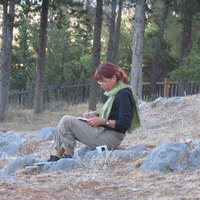Anna Philippa-Touchais
Université Paris 1 - Panthéon-Sorbonne, Archéologie, Department Member
In 2021 and 2022 research focused mainly on the study of unpublished geometric-archaic votive material from old excavations on the two acropolises of Argos: on the one hand, the votive deposit excavated by Vollgraff in 1902 on the summit... more
In 2021 and 2022 research focused mainly on the study of unpublished geometric-archaic votive material from old excavations on the two acropolises of Argos: on the one hand, the votive deposit excavated by Vollgraff in 1902 on the summit plateau of Aspis, on the other hand, the similar deposit explored inside the Larissa fortress, first by Vollgraff in 1928-1930 then by Courbin in 1954.
l'âge du Bronze à l'âge du Fer : les dépôts votifs d'époque géométrique et archaïque » [notice archéologique], Bulletin archéologique des Écoles françaises à l'étranger [En ligne], Grèce, mis en ligne le 26 avril 2023, consulté le 24 mai 2023. URL : http://journals.openedition.org/baefe/7901 Ce document a été généré automatiquement le 24 mai 2023.
l'âge du Bronze à l'âge du Fer : les dépôts votifs d'époque géométrique et archaïque » [notice archéologique], Bulletin archéologique des Écoles françaises à l'étranger [En ligne], Grèce, mis en ligne le 26 avril 2023, consulté le 24 mai 2023. URL : http://journals.openedition.org/baefe/7901 Ce document a été généré automatiquement le 24 mai 2023.
Research Interests:
The four prehistoric tumuli excavated by Spyridon Marinatos in the early 1970s at Vranas, in the Marathon plain, are considered to be one of the most important burial complexes of the Aegean Bronze Age for many reasons: they are probably... more
The four prehistoric tumuli excavated by Spyridon Marinatos in the early 1970s at Vranas, in the Marathon plain, are considered to be one of the most important burial complexes of the Aegean Bronze Age for many reasons: they are probably part of an extensive tumulus cemetery, and are distinguished for their monumental dimensions and their elaborate construction; they include a wide variety of types of tombs, from large cists with individual burials to spacious, complex constructions with side entrances and remains of numerous burials. Moreover, they cover an unusually long period of use from the beginning of the Middle to the end of the Late Bronze Age. Two of the burial mounds are preserved in a very good condition. Finally, it is worth noting that the tumuli were built in a prominent area where tombs of the Early Bronze Age pre-existed.
